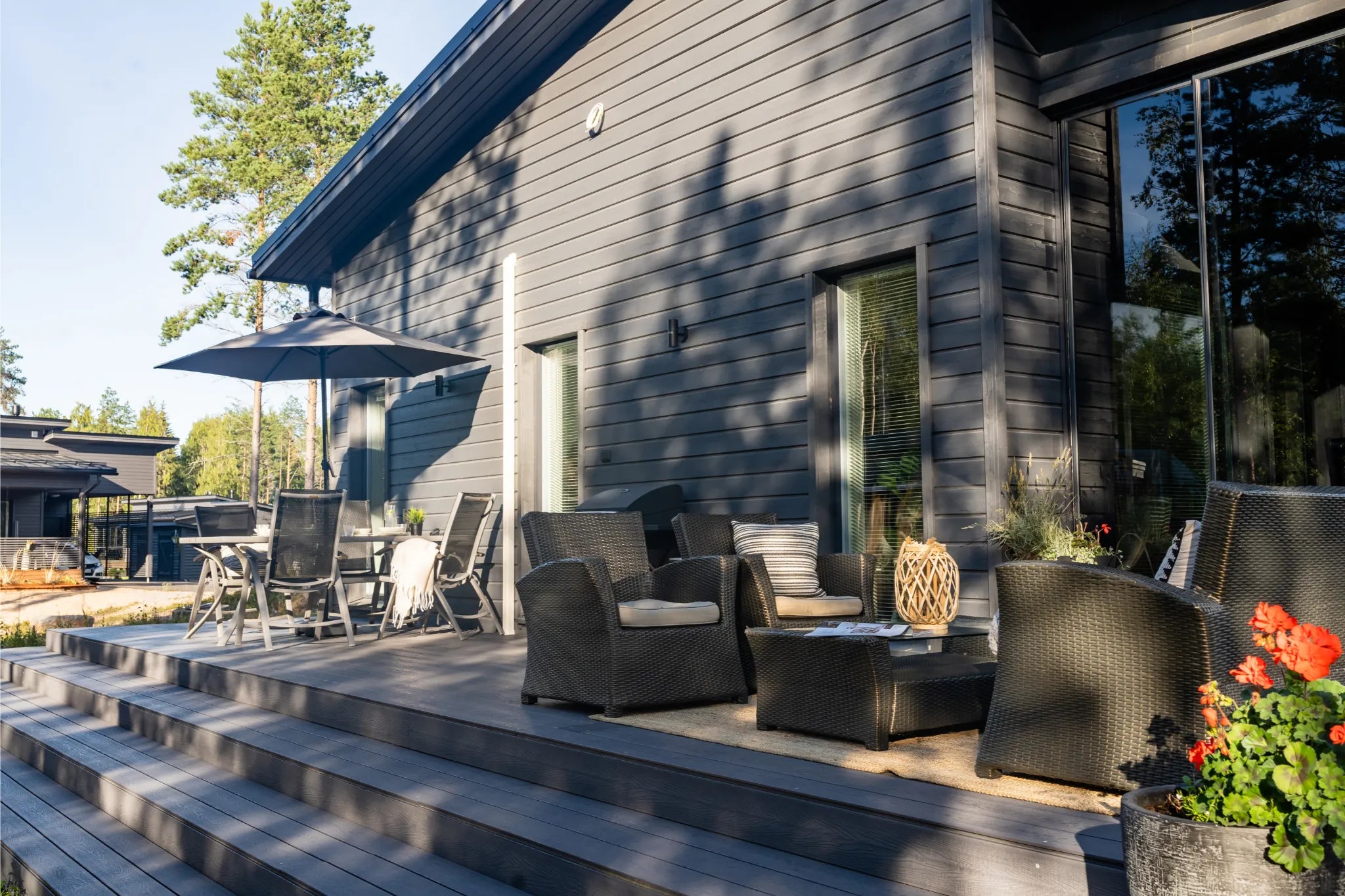When you start planning and building a deck, one of the most important decisions concerns the material choice. The choice of decking material affects not only the deck's appearance and atmosphere but also its durability and maintenance needs.
In this blog post, we delve into two popular options – wood and composite – comparing their features, advantages, and disadvantages.
Composite decks: durability and ease of maintenance
Composite deck boards are available in several different colors and surface patterns. Särkkä -deck board surface mimics real wood texture and is not slippery even when wet. You can choose your deck's preferred color from different sides of the board: antique gray or anthracite color. Dark gray Ulkokalla and brown Maakalla in addition to wood grain, offer a modern grooved option; choose your preferred profile from different sides of the board!
Although the purchase price of composite material is higher than traditional wood, its longer lifespan and lower maintenance needs can make it an economically sensible choice in the long term.
Wood deck: closeness to nature and warmth
A wood deck is a traditional choice that offers an authentic, natural atmosphere. The warmth, textures, and natural beauty of wood are unmatched. The market offers many different wood deck options, such as pressure-treated wood, thermally modified wood, larch, and spruce.

Wood deck offers a natural atmosphere
Pressure-treated wood
Pressure-treated wood is the most popular and traditional choice among deck boards. Its popularity is based on its durability and more affordable price. Pressure-treated wood is wood treated under pressure with strong preservatives in a sealed container using water and pressure variations. Thanks to this treatment, the wood does not rot as easily as untreated wood.
The lifespan of pressure-treated wood depends, among other things, on the deck's usage conditions and maintenance. It is recommended to treat and maintain pressure-treated wood at least every two years. Treatment reduces wear and wood graying, among other things.
Waste pieces of pressure-treated wood cannot be burned at home because burning may produce toxic compounds. Unnecessary sanding of the wood should also be avoided. Treated wood must be disposed of in a separate collection at a waste station.
Spruce
A natural alternative to traditional pressure-treated deck boards is a deck board made from spruce. Pauha deck board is a domestic and completely toxin-free product.
The surface of the Pauha deck board is lightly brushed, bringing out the most wear-resistant part of the wood. This results in a product that is not only durable but also wonderfully tactile, with a surface that is not slippery even when wet. The ecological deck board contains no toxins, so waste pieces can be disposed of by burning.

Pauha deck board the surface is lightly brushed
Pauha deck boards are treated with a gray-toned water-based Teknoshield 4015-00 wood oil. For the best durability, Pauha deck boards are recommended to be treated annually, either with Woodex Wood oil or the water-based version Woodex Aqua Wood Oil. These natural wood oils can be tinted to the original Poro Woodex 5087 shade if desired. During installation, we recommend treating the cut surfaces of the deck boards with these products.
Thermally modified wood
Thermally modified wood offers a beautiful color and good weather resistance without chemical treatments. Thermally modified wood is produced by modifying wood at temperatures above 160 degrees Celsius, which improves the material's resistance to decay, weather, and thermal insulation properties, and reduces wood moisture movement. At such high temperatures and with steam, resin is also removed from the wood fibers.
Thermowood is a more environmentally friendly option than treated wood, as it can be recycled in the same way as untreated wood. Thermowood should also be surface-treated and maintained regularly. Treatment reduces, among other things, wood graying, cracking, and splintering.
Selection criteria: consider these points when making your choice
When choosing deck material, it is important to consider at least the following factors:
– Appearance and style: What style and atmosphere do you want for your deck? Do you value the naturalness of wood or the versatility of composite?
– Durability and maintenance needs: How much time and money are you willing to invest in maintaining your deck? Composite may be a better choice if low maintenance is a priority.
– Budget: Consider long-term costs, including purchase, installation, and maintenance. The higher initial investment in composite may pay off through reduced maintenance expenses.

A high-quality deck is an investment in your home's comfort and value.
The choice between wood and composite depends on personal preferences, lifestyle, and budget. Both materials offer their own advantages and challenges. The warmth and beauty of traditional wood appeal to many, while the low maintenance and durability of composite make it an attractive option for a modern lifestyle. The final decision largely depends on what you value: Is your goal to create the most natural and traditional outdoor space, or do you want to invest in a material that offers ease and durability with less effort?
Building or renovating a deck is an investment in your home's comfort and value, so carefully explore the options and make a decision that best serves both your immediate and long-term needs. Once you have made your choice, it is important to invest in careful planning. With a good and thoroughly thought-out plan, it is easy to start creating a deck that suits your needs perfectly! Begin planning by exploring the comprehensive to our deck construction guide or get inspired On an eternal holiday from the family's deck renovation.





